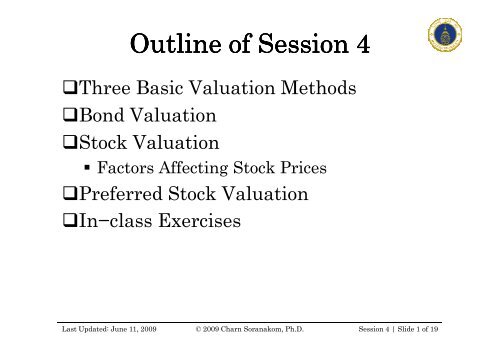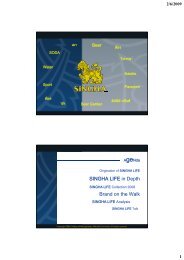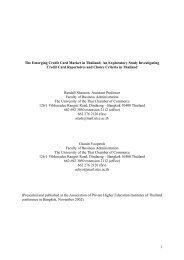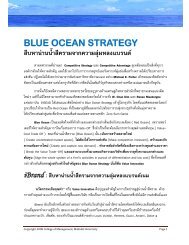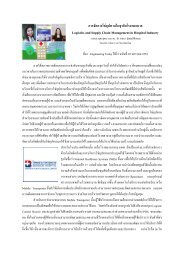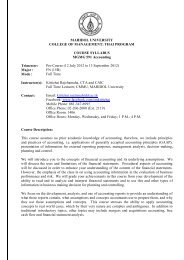Outline of Session Outline of Session 4
Outline of Session Outline of Session 4
Outline of Session Outline of Session 4
You also want an ePaper? Increase the reach of your titles
YUMPU automatically turns print PDFs into web optimized ePapers that Google loves.
<strong>Outline</strong> <strong>of</strong> <strong>Session</strong> 4<br />
Three Basic Valuation Methods<br />
Bond Valuation<br />
Stock Valuation<br />
Factors Affecting Stock Prices<br />
Preferred Stock Valuation<br />
In−class Exercises<br />
Last Updated: June 11, 2009 © 2009 Charn Soranakom, Ph.D. <strong>Session</strong> 4 | Slide 1 <strong>of</strong> 19
A Few Words on Valuation<br />
There are three basic valuation methods, namely,<br />
Discounted Cash Flow (DCF) Method<br />
Relative Valuation Method<br />
Contingent−Claim Method<br />
Values <strong>of</strong> securities rarely stay constant.<br />
Valuation is not a one−time job. Re−valuation is always<br />
needed.<br />
We usually don’t observe the discount rates. We<br />
observe prices instead and infer discount rates from<br />
changes in prices. The return is the discount rate.<br />
In a well−functioning financial market, we can<br />
estimate a discount rate for each type <strong>of</strong> security <strong>of</strong><br />
varying degree <strong>of</strong> risk.<br />
Last Updated: June 11, 2009 © 2009 Charn Soranakom, Ph.D. <strong>Session</strong> 4 | Slide 2 <strong>of</strong> 19
Bonds<br />
Bonds are one type <strong>of</strong> fixed income security.<br />
Various types <strong>of</strong> bonds<br />
Government bonds<br />
Corporate bonds<br />
Pure discount (or Zero−coupon) bonds<br />
Console<br />
A typical bond has the following information<br />
on it.<br />
Maturity date<br />
Coupon rate (can be fixed or floating rate)<br />
Frequency <strong>of</strong> interest payments per year<br />
Face value<br />
Last Updated: June 11, 2009 © 2009 Charn Soranakom, Ph.D. <strong>Session</strong> 4 | Slide 3 <strong>of</strong> 19
Bond Valuation<br />
We use the DCF method to value a bond and<br />
get the bond price.<br />
To value a bond, we just discount periodic<br />
interest payments and face value <strong>of</strong> a bond at<br />
the prevailing market interest rate<br />
appropriate for its risk class.<br />
Bond Price =<br />
Int<br />
1<br />
+<br />
2<br />
( 1 + YTM) ( ) ( ) N<br />
Yield−to−Maturity (YTM) is a discount rate<br />
that solves the above equation.<br />
Int<br />
Bond price and its yield is jointly determined.<br />
Last Updated: June 11, 2009 © 2009 Charn Soranakom, Ph.D. <strong>Session</strong> 4 | Slide 4 <strong>of</strong> 19<br />
2<br />
1 + YTM<br />
Int<br />
+ ... +<br />
N<br />
+ Face Value<br />
1 + YTM
Calculation <strong>of</strong> Bond Price<br />
Example:<br />
A 5−year 5%−coupon government bond is<br />
being issued.<br />
This bond pays interest annually.<br />
Its face value is 100,000 Baht.<br />
The prevailing market interest rate for a<br />
5−year risk−free bond is 5%.<br />
5,000 5,000 5,000 5,000 5,000 + 100,000<br />
Bond Price = + + + +<br />
5<br />
2<br />
3<br />
4<br />
( 1 + 5% ) ( 1 + 5% ) ( 1 + 5% ) ( 1 + 5% ) ( 1 + 5% )<br />
= 100,000 Baht<br />
Last Updated: June 11, 2009 © 2009 Charn Soranakom, Ph.D. <strong>Session</strong> 4 | Slide 5 <strong>of</strong> 19
What−if the Interest Rate Changes<br />
If the prevailing market interest rate for a<br />
5−year risk−free bond is 6%, then<br />
5,000 5,000 5,000 5,000 5,000 + 100,000<br />
Bond Price = + + + +<br />
5<br />
2<br />
3<br />
4<br />
( 1 + 6% ) ( 1 + 6% ) ( 1 + 6% ) ( 1 + 6% ) ( 1 + 6% )<br />
= 95,787.64 Baht<br />
If the prevailing market interest rate for a<br />
5−year risk−free bond is 4%, then<br />
5,000 5,000 5,000 5,000 5,000 + 100,000<br />
Bond Price = + + + +<br />
5<br />
2<br />
3<br />
4<br />
( 1 + 4% ) ( 1 + 4% ) ( 1 + 4% ) ( 1 + 4% ) ( 1 + 4% )<br />
= 104,451.82 Baht<br />
Last Updated: June 11, 2009 © 2009 Charn Soranakom, Ph.D. <strong>Session</strong> 4 | Slide 6 <strong>of</strong> 19
These curves<br />
are convex.<br />
Last Updated: June 11, 2009 © 2009 Charn Soranakom, Ph.D. <strong>Session</strong> 4 | Slide 7 <strong>of</strong> 19
Bond Price Relationship to YTM<br />
When the coupon rate = the market<br />
interest rate (YTM), a bond will sell at<br />
par.<br />
When the coupon rate > the YTM, a<br />
bond will sell at a premium.<br />
When the coupon rate < the YTM, a<br />
bond will sell at a discount.<br />
But why?<br />
Last Updated: June 11, 2009 © 2009 Charn Soranakom, Ph.D. <strong>Session</strong> 4 | Slide 8 <strong>of</strong> 19
Interest Rate Risk (or Price Risk)<br />
Interest Rate Risk sometimes is called “Price Risk”.<br />
Investment in bonds (even in a risk−free bond like a<br />
government bond) can be risky due to fluctuation in<br />
the market interest rates.<br />
As you can see, when the market interest rate goes up,<br />
bond price declines, and vice versa, resulting in a gain<br />
or loss.<br />
Notes:<br />
Bond price does not decline in linear fashion.<br />
The longer the maturity <strong>of</strong> a bond, the greater the<br />
price risk, other things being equal. Why?<br />
The lower the coupon rate <strong>of</strong> a bond, the greater the<br />
price risk, other things being equal. Why?<br />
Last Updated: June 11, 2009 © 2009 Charn Soranakom, Ph.D. <strong>Session</strong> 4 | Slide 9 <strong>of</strong> 19
Common Stock<br />
Common Stock (or just “Stock”) is a security,<br />
which represents ownership in a company.<br />
Owning a stock entitles you to some share <strong>of</strong> a<br />
company’s pr<strong>of</strong>its (or dividends).<br />
Shareholders are last in line to claim against a<br />
company’s assets in the event <strong>of</strong> bankruptcy.<br />
Investment in stocks therefore is considered<br />
more risky than investment in bonds.<br />
Investment returns in stocks include capital<br />
gains/losses and dividends.<br />
© 2009 Charn Soranakom, Ph.D.<br />
Last Updated: June 11, 2009 © 2009 Charn Soranakom, Ph.D. <strong>Session</strong> 4 | Slide 10 <strong>of</strong> 19
Stocks and the Stock Market<br />
Stocks are traded in the stock market.<br />
You need a broker to trade stocks.<br />
Know the differences between<br />
Primary market and Secondary market<br />
Auction market and Dealer market<br />
Capital gains/losses and dividends<br />
Understand<br />
Bids, asks, and prices<br />
P/E and P/B ratios<br />
Dividend yield<br />
Commissions and taxes<br />
Last Updated: June 11, 2009 © 2009 Charn Soranakom, Ph.D. <strong>Session</strong> 4 | Slide 11 <strong>of</strong> 19
Stock Valuation<br />
Same DCF concept applies.<br />
To value a stock and get a stock price, you<br />
simply discount expected dividend and stock<br />
price next year at the rate <strong>of</strong> return<br />
appropriate for its risk class.<br />
For example:<br />
ABC stock will pay 10−Baht dividend next year.<br />
You expect the stock price to be 110 Baht next year.<br />
What should be the current stock price?<br />
P<br />
0<br />
=<br />
Div<br />
1<br />
+<br />
( 1 + r ) ( 1 + r )<br />
S<br />
P<br />
1<br />
10 + 110<br />
=<br />
S<br />
Last Updated: June 11, 2009 © 2009 Charn Soranakom, Ph.D. <strong>Session</strong> 4 | Slide 12 <strong>of</strong> 19
P<br />
P<br />
0<br />
1<br />
=<br />
=<br />
Div<br />
1<br />
( 1 + r ) ( 1 + r )<br />
Div<br />
S<br />
2<br />
+<br />
P<br />
1<br />
S<br />
( 1 + r ) ( 1 + r )<br />
S<br />
+<br />
P<br />
2<br />
S<br />
P<br />
P<br />
0<br />
0<br />
1<br />
⎡<br />
⎢<br />
Div<br />
⎣<br />
⎛ Div<br />
2<br />
+ P<br />
+<br />
⎜<br />
⎝ +<br />
S<br />
2<br />
=<br />
=<br />
1<br />
( 1 + r<br />
) ⎜<br />
( 1 r<br />
)<br />
Div<br />
S<br />
1<br />
2<br />
( 1 + r ) ( ) ( ) 2<br />
S<br />
+<br />
Div<br />
1 + r<br />
S<br />
2<br />
+<br />
P<br />
2<br />
1 + r<br />
S<br />
⎞⎤<br />
⎟<br />
⎥<br />
⎠⎦<br />
P<br />
0<br />
=<br />
Div<br />
1<br />
+<br />
+<br />
+ ...<br />
2<br />
3<br />
( 1 + r ) ( ) ( ) ( ) ∞<br />
S<br />
Div<br />
1 + r<br />
S<br />
2<br />
Div<br />
1 + r<br />
S<br />
3<br />
Div<br />
1 + r<br />
S<br />
∞<br />
Last Updated: June 11, 2009 © 2009 Charn Soranakom, Ph.D. <strong>Session</strong> 4 | Slide 13 <strong>of</strong> 19
Stock Valuation (cont…)<br />
Case 1: Assuming no growth in dividends<br />
Div1<br />
Div1<br />
P<br />
0<br />
=<br />
r<br />
S<br />
=<br />
r or P<br />
S<br />
Case 2: Assuming a constant growth in dividends (g%)<br />
Div1<br />
Div1<br />
P<br />
0<br />
=<br />
r<br />
S =<br />
+<br />
g<br />
r<br />
−<br />
g or<br />
P<br />
S<br />
Case 3: Assuming a non−constant growth in dividends<br />
P<br />
0<br />
=<br />
Div<br />
1<br />
2<br />
( 1 + r ) ( 1 + r ) ( 1 + r )<br />
S<br />
+<br />
Div<br />
S<br />
2<br />
+ ... +<br />
Div<br />
S<br />
t<br />
t<br />
+<br />
0<br />
0<br />
⎡Div<br />
⎢<br />
⎣ r<br />
t<br />
S<br />
( 1 + g)<br />
−g<br />
( 1 + r ) t<br />
S<br />
⎤<br />
⎥<br />
⎦<br />
Last Updated: June 11, 2009 © 2009 Charn Soranakom, Ph.D. <strong>Session</strong> 4 | Slide 14 <strong>of</strong> 19
Where Does g Come From?<br />
Year<br />
1 2 3 4<br />
BV <strong>of</strong> Equity per Share 100.00 105.00 110.25 115.76<br />
Return on Equity (ROE) 10.00% 10.00% 10.00% 10.00%<br />
Earnings per Share (EPS) 10.00 10.50 11.03 11.58<br />
Payout Ratio 50.00% 50.00% 50.00% 50.00%<br />
Retention Ratio (1−Payout<br />
Ratio) 50.00% 50.00% 50.00% 50.00%<br />
Dividend per Share (DPS) 5.00 5.25 5.51 5.79<br />
Growth Rate in Dividends (g) 5.00% 5.00% 5.00%<br />
Growth Rate in EPS (g) 5.00% 5.00% 5.00%<br />
Growth Rate in Stock Price (g) 5.00% 5.00% 5.00%<br />
Stock Price (assuming PE=20) 200.00 210.00 220.50 231.53<br />
Last Updated: June 11, 2009 © 2009 Charn Soranakom, Ph.D. <strong>Session</strong> 4 | Slide 15 <strong>of</strong> 19
Factors Affecting Stocks’ Prices<br />
Change in forecast <strong>of</strong> earnings and<br />
dividends (EPS and DPS)<br />
Change in forecast <strong>of</strong> growth (g)<br />
Change in expectation <strong>of</strong> rate <strong>of</strong> return<br />
(r S )<br />
Supply and demand<br />
Price manipulation<br />
Psychology factor<br />
Market sentiment<br />
Last Updated: June 11, 2009 © 2009 Charn Soranakom, Ph.D. <strong>Session</strong> 4 | Slide 16 <strong>of</strong> 19
Preferred stock<br />
is classified as equity.<br />
Preferred Stock<br />
owner usually cannot vote, but may be allowed to vote if<br />
dividends have not been paid for some time.<br />
(usually) pays fixed dividends as a percentage <strong>of</strong> par value.<br />
has higher priority <strong>of</strong> claims against company’s assets and<br />
pr<strong>of</strong>its (dividends) over common stock.<br />
dividends can be cumulative or noncumulative.<br />
has characteristics <strong>of</strong> a debt, but dividend is not<br />
tax−deductible.<br />
is not popular among investors. Therefore, corporations do not<br />
want to issue this type <strong>of</strong> security.<br />
Last Updated: June 11, 2009 © 2009 Charn Soranakom, Ph.D. <strong>Session</strong> 4 | Slide 17 <strong>of</strong> 19
Preferred Stock Valuation<br />
Use DCF method.<br />
Discount preferred dividends at the<br />
appropriate discount rate to obtain the<br />
price <strong>of</strong> preferred stock.<br />
For example:<br />
XYZ preferred stock pays 1−Baht dividend. If you<br />
discount at 10%, you get a price <strong>of</strong> 10 Baht per share.<br />
1 1<br />
Preferred Stock Price<br />
+<br />
2<br />
=<br />
( 1 + 10% ) ( 1 + 10% ) ( 1 + 10% )<br />
1<br />
10%<br />
= 10 Baht<br />
+ ... +<br />
=<br />
∞<br />
1<br />
Last Updated: June 11, 2009 © 2009 Charn Soranakom, Ph.D. <strong>Session</strong> 4 | Slide 18 <strong>of</strong> 19
In−class Exercises<br />
Let’s do some exercises in class together.<br />
Last Updated: June 11, 2009 © 2009 Charn Soranakom, Ph.D. <strong>Session</strong> 4 | Slide 19 <strong>of</strong> 19


